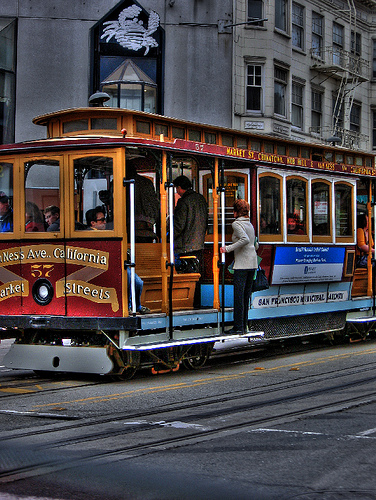The Amazing Race: San Francisco
733 Kearny Street
San Francisco, CA
United States
operator
Resources
About San Francisco
Getting Around & Finding Landmarks
- SF Muni Info
- NextMuni - Realtime Bus/Streetcar/Subway Predictions
- 511.org transit info and planner
- Flickr
Phone Support
- Dial 311 for The City of San Francisco's 24x7 free customer service center.
- 511 Bay Area transit info.
Useful iPhone Apps
- Yelp
- Inquisitor
- Flickr
- Yahoo! Messenger
- Google Earth
- Routesy

About Getting Around
(Courtesy of Trip Advisor)
While San Francisco may be one of the “biggest” tourist destination in the United States, geographically it is surprisingly small. Located on tip of a peninsula, the city constitutes an area of only 7 miles wide by 7 miles long. It is a compact and walkable city that offers a wide range of transportation options that preclude the need for a car. If you are looking for a workout, use nothing but your own two feet and you will likely find yourself in better shape by the end of your voyage to San Francisco!
The primary means of public transportation in and around the city are the San Francisco Municipal Railway (MUNI) and the Bay Area Rapid Transit (BART). The Muni is an extensive network of buses, light rail, historical streetcars, and, of course, the cable cars. With 85 lines, Muni serves nearly all corners of the city, but covers the more popular sites particularly well.
One caution about riding the cable cars: plan lots of time to get to your destination, especially if you are traveling near peak times, like in early evening when people are migrating towards their chosen dining spots. Lots of folks like going down to Fisherman's Wharf for dinner, and the cable cars fill up fast in the Union Square area. At the end of the Powell/Hyde and the Powell/Mason lines on Market Street just south of Union Square, a long line forms for folks waiting to get on. Both lines will take you down to Fisherman's Wharf area, with one ending a few blocks east of the other. However, sometimes the cable operators at the Market street terminus will not allow riders to board in order to leave room for the folks who are waiting at other stops further up the line (like two or three blocks). If they did not do this, then every cable car would be filled when it reaches these other stops. Sometimes the cable car operators will send an empty car up the line and sometimes they will limit the number of people they allow on, but both for the same reason: to leave room for folks at the other stops. Based on volume and the number of stops the cable car makes, the key point is to leave plenty of time, especially if you are going from the Union Square area down to the Fisherman's Wharf area.
Another great option to get from the Union Square area to Fisherman's Wharf is to take the F-line street car. It goes along the Embarcadero to Fisherman's Wharf. However, a similar warning in terms of timing. During peak times, like late afternoon when folks are leaving work in the wharf area, or tourists are leaving the wharf area to go back to their hotels, the cars will fill up and will pass by stops if they are full. Not to worry; they run about every 10 minutes. Another strategy to consider is to walk a couple blocks back up the line to a muni stop that does not have as many people waiting. In other words, if you are waiting at a stop where there are lots of people waiting, walk back to another stop, in the opposite direction from your destination, but potentially to a stop without as many people waiting, and you will have a better chance of getting on the street car.
Just one more caution for peak travel times including early evening when tourists are looking to travel to their dining spots: taxis can be hard to find. The hotels will have lines for taxis and they will come as frequently as they can, but it can take a little time to get one, so plan accordingly.
Confused? An indispensable phone information line, manned by the city, when trying to get to Point A to Point B in the city: 311.
Copyright SF Racer. All rights reserved.
733 Kearny Street
San Francisco, CA
United States
operator